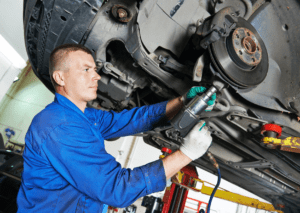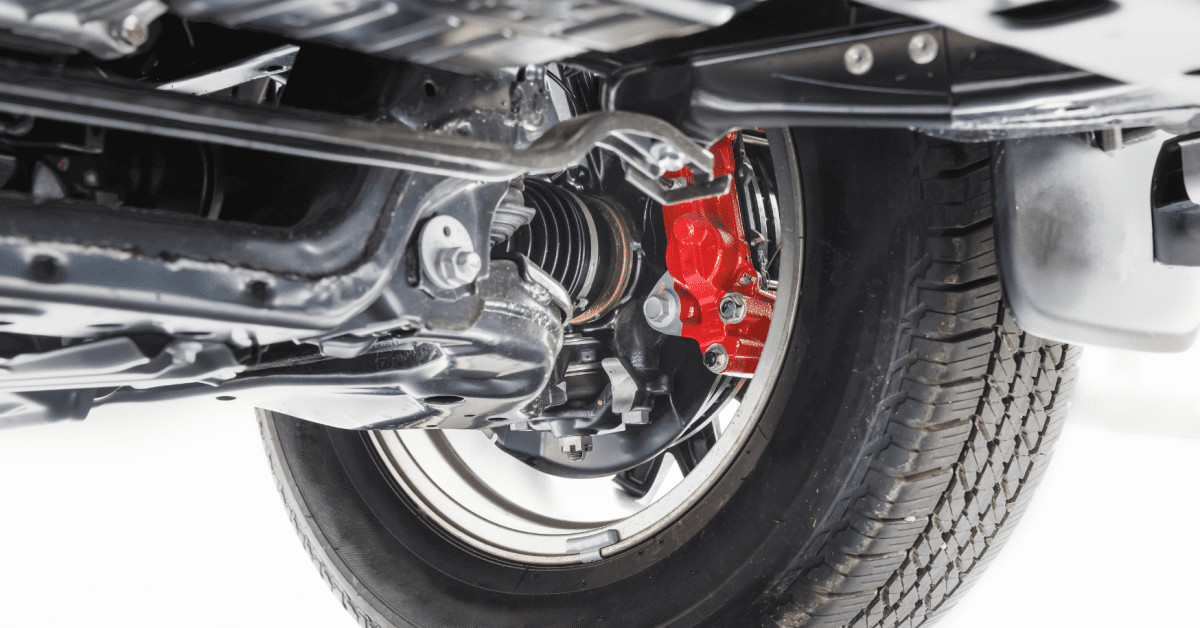The smoothness of your ride, the handling of your car, and your overall driving safety rely on two critical systems working together—the suspension and steering systems. These two systems not only provide a comfortable driving experience but also ensure precise vehicle control, especially in demanding road conditions. Understanding how the suspension & steering systems interact is key to maintaining your car’s performance and safety.
What is the Steering System?

The steering system is responsible for controlling the direction of your vehicle’s wheels, allowing you to navigate turns and maintain control over the car’s movements. The primary car steering components include:
- Steering Wheel: The part of the car you physically turn to control the vehicle’s direction.
- Steering Column: This connects the steering wheel to the rest of the steering system, transmitting your input.
- Rack and Pinion: A mechanism that converts the rotational motion of the steering wheel into the linear motion needed to turn the wheels.
- Tie Rods: These connect the steering system to the wheels, ensuring they turn in response to your movements.
- Ball Joints: These allow for flexible movement in the steering system, giving the wheels the ability to pivot.
Each of these components plays a vital role in allowing the driver to control the car’s direction. The system relies on precise mechanical movements, and when everything is working correctly, the steering is smooth and responsive. However, any malfunction—like worn-out tie rods or ball joints—can result in poor handling or even a complete loss of control.
The Role of the Suspension System

While the steering system helps you direct your vehicle, the suspension system ensures that the ride is smooth and that the car remains stable, even on rough or uneven terrain. The suspension system includes:
- Springs: These support the vehicle’s weight and absorb shocks from the road.
- Shock Absorbers: These dampen the movement of the springs, preventing the car from bouncing excessively.
- Struts: A combination of a shock absorber and a spring, commonly used in modern vehicles.
- Control Arms: These connect the suspension to the wheel assembly, allowing the wheels to move up and down while staying aligned with the vehicle.
The suspension system not only enhances comfort by absorbing road imperfections but also plays a crucial role in maintaining tire contact with the road. This improves traction, stability, and overall handling, ensuring that the car responds predictably when you steer.
How Suspension & Steering Systems Work Together
The suspension and steering systems are interconnected in many ways, and their proper function is crucial for both vehicle handling and comfort. The suspension & steering systems interact by ensuring that the tires remain in contact with the road and that the driver has precise control over the vehicle’s direction, regardless of the terrain.
Here’s how these systems complement each other:
- Wheel Alignment: The suspension system keeps the wheels aligned, which is essential for accurate steering. Misaligned wheels can make the car pull to one side, affect handling, and cause uneven tire wear.
- Ball Joints and Tie Rods: These components are part of both the steering and suspension systems. Ball joints allow for smooth movement between the steering knuckle and control arms, while tie rods connect the steering system to the wheels, ensuring proper directional control.
- Stability and Traction: The suspension system ensures that the tires stay in contact with the road, which is essential for the steering system to function effectively. A bumpy or unstable ride can cause the steering to feel loose or imprecise, which can make controlling the car difficult.
For example, if your suspension system is faulty and one of the tires isn’t making proper contact with the road, the steering system will struggle to maintain control, leading to poor handling, especially during turns or abrupt maneuvers.
Signs of Problems in Suspension & Steering Systems

Both the suspension and steering systems require regular maintenance, and there are clear warning signs that something may be wrong. Here are some common symptoms of suspension and steering issues:
- Difficulty Steering: If the steering wheel feels stiff or doesn’t respond as smoothly as it should, it could indicate a problem with the power steering system or worn-out tie rods.
- Uneven Tire Wear: If your tires are wearing unevenly, it may be a sign of poor wheel alignment or suspension issues.
- Loose or Wobbly Steering Wheel: A loose or wobbly steering wheel could point to problems in the steering column, ball joints, or other components.
- Bumpy Ride: If you notice that your car is bouncing excessively or feels unstable, it could be a sign that the shock absorbers or struts are worn out.
- Strange Noises When Turning: Knocking or clunking noises while turning may indicate worn ball joints or other steering components.
Ignoring these signs can result in costly repairs or, worse, accidents. Keeping your suspension and steering systems in top condition is crucial for your safety and the overall longevity of your vehicle.
The Importance of Regular Maintenance
Proper maintenance of both the suspension and steering systems is key to ensuring they work together efficiently. Regular inspections and replacing worn-out parts can prevent issues from escalating into major problems. Some essential maintenance tasks include:
- Wheel Alignment Checks: Regularly checking and adjusting your wheel alignment helps prevent uneven tire wear and improves handling.
- Suspension Inspection: Routine inspections of the springs, shock absorbers, and struts ensure that the suspension system is functioning properly and maintaining traction.
- Steering System Checks: Checking the condition of your steering components, like the rack and pinion, tie rods, and ball joints, ensures that you maintain full control over your vehicle.
A well-maintained car will not only provide a safer, smoother ride but will also reduce the likelihood of expensive repairs down the road.
Keep Your Suspension & Steering Systems in Check
Is your car’s ride feeling rough or is the steering less responsive? Metric Motors is here to help! Our expert mechanics in Loveland specialize in maintaining suspension and steering systems to ensure your vehicle stays safe and handles smoothly. Don’t wait—schedule a suspension and steering system inspection today and keep your car performing at its best. Metric Motors: Where safety and comfort meet precision!
Conclusion
The suspension & steering systems in your vehicle are intricately connected, working together to provide control, stability, and comfort. Understanding how these systems function and recognizing the signs of trouble can help you maintain your car’s performance and safety. Regular maintenance of both systems ensures that you enjoy a smoother, more reliable ride while minimizing the risk of costly repairs. If you notice any issues with your vehicle’s handling, steering, or suspension, it’s essential to seek professional help immediately. By doing so, you’ll keep your car running safely and smoothly for years to come.
FAQ Section:
Q: What is the role of the steering system in a car?
A: The steering system controls the direction of your vehicle, allowing you to navigate turns and control movements. It consists of components like the steering wheel, steering column, rack and pinion, tie rods, and ball joints, all of which work together to ensure precise handling and control.
Q: What does the suspension system do?
A: The suspension system maintains vehicle stability and provides a smooth ride by absorbing road shocks. It includes components such as springs, shock absorbers, struts, and control arms, which help the tires maintain contact with the road, enhancing traction and comfort.
Q: How do the suspension and steering systems work together?
A: The suspension and steering systems are interconnected, working together to provide control, stability, and comfort. The suspension keeps the wheels aligned and in contact with the road, while the steering system ensures precise directional control. A malfunction in one system can impact the other, reducing overall vehicle performance.
Q: What happens if the suspension system fails?
A: If the suspension system fails, the car will have reduced traction, making it harder to maintain control, especially on uneven or bumpy roads. You may experience a rough, unstable ride, and the steering system may become imprecise, leading to unsafe driving conditions.
Q: How often should suspension and steering systems be maintained?
A: Regular maintenance, including inspections and part replacements, should be done at least annually or whenever you notice symptoms of trouble. Routine wheel alignment checks, suspension inspections, and steering system evaluations are crucial for preventing more serious issues.






